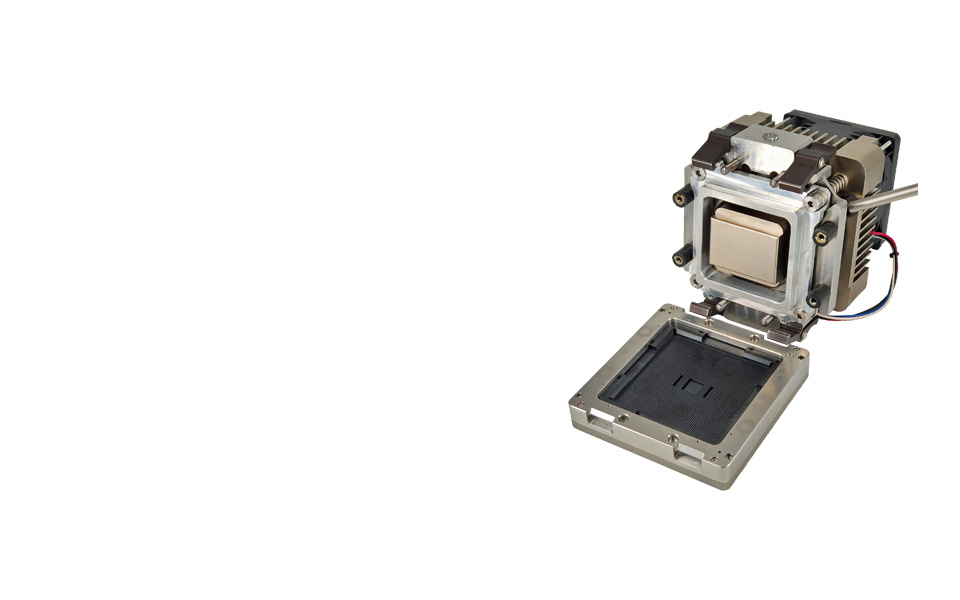Not every semiconductor manufacturer utilizes thermal simulation in their reliability testing setup. Lower power burn-in allows for an acceptable temperature rise within the package/die in a traditional burn-in chamber running at 125°C. As packages in burn-in are moving to higher power output, socket and burn-in systems may need to have enhanced features to manage the desired target die temps. At Smiths Interconnect, we conduct thermal simulation prior to burn-in board and socket manufacture to more effectively narrow down and identify necessary features for sockets and systems. Then, we’re set up for efficiency in the burn-in testing phase.
Defining thermal simulation
Thermal simulation is required to ensure the socket design parameters cooperate with the burn-in system to maintain target die temp. Thermal simulation takes away a lot of the extra iteration, so that we see specifically where to make changes and adjustments for the best outcome.
With this full representation of our product in the context of our customer’s system, we can narrow a more exact, particular solution for what they need.
When is thermal simulation necessary?
Our high-power test sockets are built to handle the most extreme temperatures, which means we work with many customers whose devices run at peak heat. So, we utilize thermal simulation often.
Here’s how we determine whether thermal simulation is necessary.
The customer sets a temperature we need to test at – and we provide the hardware to withstand that temperature and to help cool that temperature down to the desired point.
Whether or not we conduct thermal analysis depends on the nature of the device.
- Is it a standard low-power device that will experience standard, lower temperatures?
- Or is it a high-power device that will experience higher temperature
As soon as you cross over to high-power, you start having to answer these questions about heat resistance. When working with high-power/high-temp devices, we need to utilize thermal analysis.
The other case where we may not need thermal simulation is if we have worked with a similar device with similar needs or requirements before. We use our expertise to better predict what’s going to happen based on a known precedent of what we’ve already done. That way, we’re able to save time in the burn-in process.
The importance of high-power sockets and inner components in thermal simulation and burn-in testing
Our job is to ensure we put the right components into the customer’s socket, whether it’s heat sinks, fans, water blocks, etc. Then, we conduct the simulation and adjust components accordingly. It can get a little tricky when we have parts that are tiny relative to big ones.
For example, a customer could have a smaller surface with a 10-watt temperature rise. So, while the wattage is lower, the surface area is so small that the package may overheat and melt. Through thermal simulation, we’re able to see if a high-power socket will withstand the temperature rise for such a small surface.
In thermal testing, we’re able to see if sockets are even the right component. Our experts can make recommendations outside of socket design.
What happens after thermal simulation?
Once we know the problem and establish solutions unique to your application, we start putting your product to the test, moving into the burn-in phase.
Burn-in testing – or high-temperature operating life (HTOL) testing – is a testing process designed to detect early failures in components and reduce the potential for defects and failures in the field. During burn-in, the component endures extreme operating conditions, including temperature extremes, high-use cycles, and high voltages.
Performing burn-in accelerates a component’s lifespan beyond the point of premature failures to weed out defective parts. Components that have passed the burn-in test are highly likely to provide reliable service for the duration of a product’s life.
Summary of our high-power burn-in testing process:
- Thermal simulations: we identify the issue and make solid predictions for improving efficiency within each socket’s makeup.
- Components built to handle the extreme: our socket solutions can handle up to 200°C (392°F) and accommodate higher pin counts, making them suitable for high-performance electronic devices.
- Improved electrical performance: Smiths Interconnect socket solutions offer enhanced electrical performance, with better signal integrity, lower crosstalk, and better impedance control.
- Customization: We offer greater design flexibility, allowing for customization and optimization of the socket design to meet specific application requirements (for cooling and heating inter components, for example).
- Cost- and time-effectiveness: Sockets are produced through automated assembly, reducing manufacturing time and costs.
- Expert engineering support: Our US-based experts can work real-time (also global).


